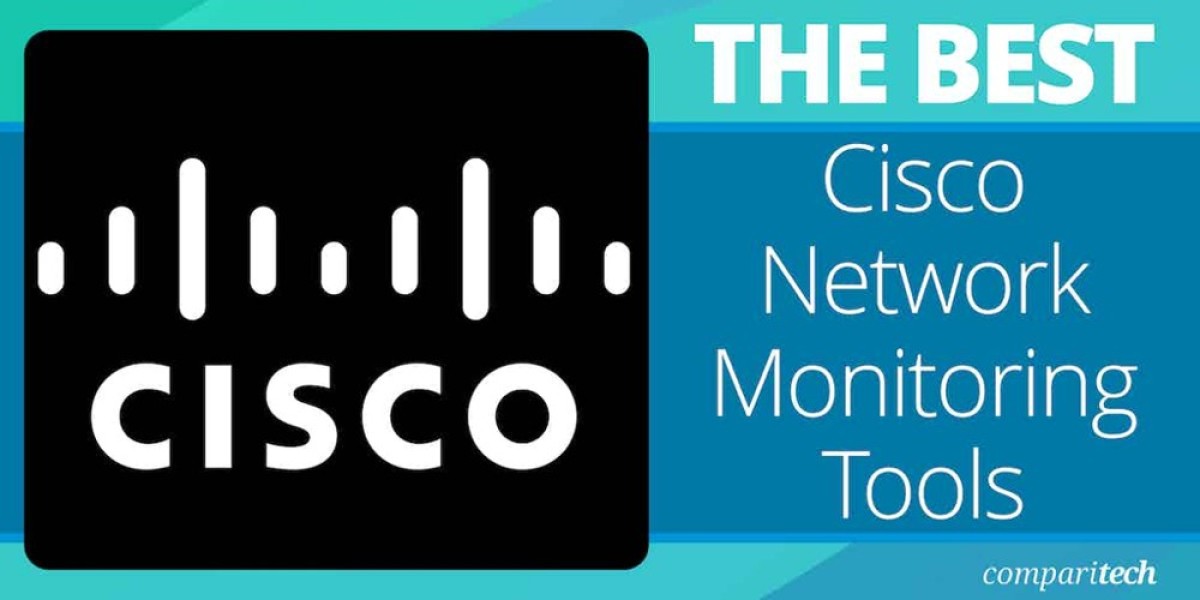Cisco Network Monitoring Tools
Cisco Systems is renowned for its production of a diverse range of network hardware, including routers, switches, gateways, firewalls, and wireless access points.
When it comes to monitoring your network effectively, there are various software solutions available.
Here’s a curated list of top Cisco network monitoring tools:
ManageEngine OpManager
Recognized as the editor's choice, this software is designed for IT teams to monitor and troubleshoot network performance issues, ensuring that uptime, security, and efficiency are maintained across Cisco systems. It operates on Windows Server, Linux, AWS, and Azure, and offers a 30-day free trial.
Site24x7 Cisco Network Monitoring
This cloud-based tool provides comprehensive monitoring for IT infrastructure, applications, and end users. It allows remote monitoring of any network, no matter where it is located, and also includes a 30-day free trial.
Paessler PRTG Network Monitor
Offering a suite of network, server, and application monitoring tools, this solution includes SNMP-based health monitoring for devices. A 30-day free trial is available for users.
Nagios XI
An on-premises monitoring package that provides detailed tracking for network, server, and application statuses through SNMP, along with extensions specifically for Cisco monitoring. It is compatible with Linux.
N-able N-sight
This remote monitoring and management tool covers a variety of network devices, including those from Cisco Systems.
SolarWinds Network Performance Monitor
Regarded as a leading solution in the industry, it primarily focuses on the health tracking of network devices.
Datadog Cisco Monitoring
This monitoring tool is capable of pulling data from Cisco Meraki routers and switches, utilizing SNMP and analyzing event logs generated by the devices.
LogicMonitor
A cloud-based service that delivers device health monitoring along with metrics on network traffic.
Zabbix
An open-source network monitoring tool that boasts an intuitive interface and dynamic live status graphs for network devices.
In our analysis of the Cisco network monitoring software landscape, we evaluated tools based on several key criteria:
- Their effectiveness in monitoring Cisco network device statuses
- The ability to interface with Cisco-supported traffic sampling protocols such as NetFlow and IPFIX
-
Compatibility with devices from other manufacturers for environments that utilize multiple vendors- Historical analysis through performance metric logging.
-
Notifications for any performance-related problems.
-
A user-friendly interface featuring data visualizations like graphs, along with statistical lists.
-
Options for a free trial, demo, or a money-back guarantee to assess without risk.
-
Competitive pricing providing excellent value from the service package.
-
Detailed insights into each tool will be provided in the subsequent sections.
ManageEngine OpManager stands out as a comprehensive solution for monitoring both networks and servers.
It effectively manages a range of Cisco devices including the ASR series, Catalyst series, Nexus, and UCS .
While it primarily supports Cisco hardware, this versatile tool is compatible with devices from various manufacturers, making it an ideal choice for diverse network environments.
In addition to managing traditional LANs, OpManager also tracks wireless networks through the Cisco Wireless LAN Controller (WLC) system.
Notable Features Include:
-
Performance Monitoring for Virtualization : This feature provides critical insights by tracking the performance metrics of virtual environments.
-
Network Discovery Automation : OpManager simplifies device management with its automatic identification and mapping of network components.
-
Alert Customization : Users can set up personalized alerts for various network-related events, enabling early detection and resolution of issues.
-
Comprehensive Performance Oversight : The tool monitors key metrics such as bandwidth usage, CPU load, and memory consumption to pinpoint potential bottlenecks.
-
Wide Device Monitoring : From routers to wireless access points, OpManager covers all types of network devices.
Competing with solutions like SolarWinds Network Performance Manager, ManageEngine OpManager offers robust functionalities for server and network monitoring.
It features an integrated discovery process that catalogs each network device and generates a topology map, offering various perspectives on the network infrastructure.
The network monitoring capabilities extend to Cisco's proprietary protocols including NetFlow, IP SLA, CBQoS, and NBAR.
The Network Based Application Recognition (NBAR) feature allows for the identification of applications within the traffic flowing through routers.
This functionality supports traffic management strategies such as shaping by application, blocking specific applications, or rerouting traffic as needed.
OpManager provides a comprehensive view of router and switch configurations from a single interface. Utilizing SNMP as its primary protocol, it continuously monitors the performance and status of all connected devices, including those from Cisco Systems. Upon initialization, OpManager creates a complete inventory of devices and develops an updated network topology map through regular SNMP inquiries.
This tool is suitable for organizations of varying sizes. The basic package allows monitoring of up to 10 devices, which is ideal for smaller networks, while larger enterprises can opt for higher capacity options at an additional cost. There is also a limited free version available, which supports monitoring for just three devices.
Key features include:
-
Intuitive User Interface : The web-based interface simplifies the monitoring and management of IT infrastructure, catering to users with different levels of technical expertise.
-
Automation Features : OpManager automates routine tasks such as device discovery and configuration management, minimizing manual work and reducing the likelihood of errors.
-
Seamless Integration : It works well with other ManageEngine tools and third-party applications, enhancing overall functionality and collaboration.
-
Utilization of SNMP : This tool employs the widely recognized Simple Network Management Protocol for effective network monitoring.
-
Server Monitoring : By enabling SNMP on your server's operating system, it can be incorporated into the monitoring framework.
-
Lack of SaaS Option : The absence of a software-as-a-service (SaaS) offering may restrict options for users looking for cloud deployment solutions.
The dashboard is efficiently designed to convey a wealth of information on each screen. It features engaging charts and graphs, along with alerts generated by device agents that indicate issues. Users can set custom alert rules and personalize the dashboard layout. ManageEngine also offers a 30-day free trial of OpManager, which is compatible with both Windows Server and Linux environments.For those seeking effective Cisco network monitoring solutions, ManageEngine OpManager stands out as an excellent choice.
This tool is specifically crafted to accommodate a diverse array of network devices, including Cisco routers, switches, firewalls, and wireless access points.
Its user-friendly dashboard is a significant advantage, featuring visual representations like charts and dials that provide instant insights into the network's health.
One of OpManager's key benefits is its ability to automatically scan the network, eliminating the need for manual inventory setup.
It not only catalogs all connected devices but also generates a dynamic network topology map, both of which are continuously refreshed through ongoing scans.
With real-time performance monitoring, fault detection, and automated notifications, OpManager ensures that any network issues are promptly identified and resolved.
Administrators can easily track critical metrics such as bandwidth usage, packet loss, and device health, enabling swift action against performance disruptions.
The software’s customizable reporting features and dashboards empower users to analyze network performance and usage trends, leading to more informed decision-making.
In summary, ManageEngine OpManager excels in ease of use, robust monitoring features, and seamless integration with Cisco hardware, making it a dependable tool for enhancing and managing Cisco networks.
Explore the 30-day free trial to experience its capabilities firsthand.
Visit the official site for more information: https://www.manageengine.com/network-monitoring/download.html
Compatible with Windows Server, Linux, AWS, and Azure.
The Cisco network monitoring capabilities of Site24x7 leverage the Simple Network Management Protocol (SNMP) to effectively oversee the performance and status of network equipment. This protocol utilizes an agent that communicates with a centralized controller upon request. All Cisco routers and switches are equipped with an SNMP agent, while Site24x7 functions as the SNMP manager, gathering status information from these devices. Additionally, Site24x7 extends its monitoring reach to include Cisco firewalls and other network-connected appliances.
Key functionalities include:
-
Remote Monitoring Capability: Facilitates the observation of network devices from various locations, providing greater operational flexibility.
-
SNMP Trap Management: Converts SNMP traps into alerts, allowing for the early detection of potential network problems.
-
Comprehensive Device Monitoring: Ensures that all network devices within the infrastructure are continuously monitored.
Site24x7 operates as a Software as a Service (SaaS) solution hosted in the cloud. It offers various modules designed for overseeing networks, servers, and applications. The network monitoring functionality is organized into two distinct sections: one dedicated to device monitoring and the other focused on traffic analysis. Both sections are compatible with Cisco network devices, ensuring robust monitoring capabilities.
Site24x7 offers a cloud-based solution that eliminates the need for local software installation, making it easy to use.
It supports a wide variety of Cisco devices through its SNMP capabilities, allowing for automatic detection of all network components.
As a result, it generates a dynamic topology map and maintains an updated inventory of devices on the network.
Any changes, such as the addition, removal, or relocation of devices, are reflected in real-time in both the map and inventory.
When the device agents identify issues with monitored equipment, they proactively send a “ trap ” alert to the Site24x7 platform, which promptly translates this into an alarm or warning on the dashboard.
Being a cloud service, Site24x7 can monitor networks remotely.
It captures a wide range of metrics from Cisco devices, allowing users to customize their console display to focus on specific conditions of interest.
Key features include:
-
Holistic Monitoring: Combines network, server, and application metrics for a comprehensive overview of IT infrastructure performance.
-
Timely Alerts: Sends notifications through SMS and email to ensure users are promptly informed of critical incidents.
-
Cloud Accessibility: As a cloud-based service, it offers both scalability and remote access.
-
Limited Configuration Management: It does not include patching or configuration management features, which are vital for thorough network security and maintenance.
Site24x7 is available in both free and paid tiers.
The free plan allows monitoring of up to five websites or servers, catering to very small businesses.
For more extensive needs, there are four paid options: Starter , Pro , Classic , and Enterprise , all offering a 30-day trial for new users.
Experience Site24x7's Cisco monitoring by starting your 30-day free trial today.
Paessler PRTG Network Monitor offers a comprehensive suite of monitoring capabilities categorized into various "sensors." This powerful tool is designed to oversee networks, servers, and applications efficiently.
At the core of its functionality is the Simple Network Management Protocol (SNMP), which enables PRTG to automatically discover devices during installation and maintain an up-to-date inventory. Additionally, it generates network topology maps based on the collected inventory data.
Key Features:
-
Automatic Device Discovery: Effortlessly identifies network devices and compiles an asset inventory, streamlining network oversight.
-
Visual Topology Mapping: Delivers graphical representations of your network’s structure for enhanced clarity and management.
-
Real-Time Performance Monitoring: Displays immediate insights into network performance through dynamic graphs.
-
SNMP Utilization: Employs SNMP for efficient network monitoring and management processes.
-
Wireless Coverage Mapping: Assesses and visualizes wireless network performance to enhance optimization and troubleshooting efforts.
PRTG integrates specific monitoring capabilities for Cisco devices, allowing for both device status checks via SNMP and traffic analysis using NetFlow and IPFIX protocols. This integration includes network discovery features that build an asset inventory and create topology maps.
The dashboard displays the health status of all network devices, enhanced by color-coded visualizations such as charts and meters, making data interpretation straightforward. Notably, PRTG can monitor devices from various manufacturers, not limited to Cisco.
Upon purchasing PRTG, users acquire a set limit of sensors. Paessler provides a complete collection of available sensors, allowing users to tailor their monitoring setup by activating only the sensors they need. The Cisco System Health Sensor focuses specifically on the operational statuses of Cisco hardware, ensuring detailed oversight of these devices.
In the realm of Cisco network monitoring tools, there are several notable options to consider.
Among these, the NetFlow sensor stands out, along with SFlow and J-Flow sensors. A specific Cisco tool included in this suite is the IP SLA sensor, which utilizes service level agreement (SLA) data from Cisco switches to assess the quality of VoIP communications. The Cisco ADSL sensor is another valuable addition, providing insights into link throughput and capacity directly from Cisco routers.
PRTG excels in tracking traffic shaping through its Cisco CBQoS sensor, which retrieves queue data from Cisco switches. Additionally, network security is enhanced with the ability to monitor the Cisco Adaptive Security Appliance (ASA) firewall using PRTG’s SNMP Cisco ASA VPN Traffic sensor, as well as the Cisco ASA VPN Users sensor.
One of the key advantages of this package is its versatility, making it suitable for businesses of all sizes. It can monitor not just Cisco devices, but also equipment from various manufacturers, allowing for a comprehensive overview of the entire network landscape. The integration of server and application monitoring, along with internet and web tests, adds to its functionality.
Key features include:
-
Scalability : PRTG supports distributed monitoring, enabling users to oversee multiple networks and locations from a single interface.
-
Multi-vendor Compatibility : The tool accommodates a diverse range of vendors, devices, and technologies, ensuring comprehensive coverage of network equipment, servers, virtual machines, cloud services, and applications.
-
Real-time Monitoring : PRTG offers real-time monitoring and alerting, providing immediate notifications regarding network issues or performance drops.
-
Absence of Management Features : It’s worth noting that PRTG does not include patch management or configuration management tools, which are critical for thorough network maintenance and security.
A 30-day free trial of PRTG is available, featuring unlimited sensors during this period. Furthermore, if users maintain a limit of 100 sensors or fewer, the software can be utilized indefinitely at no cost. PRTG is compatible with Windows Server environments.
Comprehensive IT Monitoring Solutions
Nagios XI serves as a comprehensive suite for monitoring various aspects of IT infrastructure, including networks, servers, and applications. With its ability to track switch performance via SNMP, this network monitoring solution excels in ensuring operational efficiency. Users can enhance Nagios XI’s functionality through a wide array of plugins, including those tailored specifically for Cisco devices.
Key Highlights:
-
Web-Based Dashboard : Nagios XI offers a user-friendly centralized dashboard accessible through any web browser, facilitating streamlined management of IT resources.
-
Alerts and Notifications : This tool is equipped with advanced alerting mechanisms, allowing users to set specific thresholds and receive timely notifications through email or SMS.
-
Graphical Performance Metrics : Users can benefit from comprehensive performance graphs and reports generated from historical data, enabling them to analyze trends and troubleshoot effectively.
-
Simplified Configuration : With built-in wizards and templates, Nagios XI streamlines the setup process, making configuration management hassle-free.
Recognized widely for its robust capabilities, Nagios XI derives much of its acclaim from its open-source predecessor, Nagios Core. Both platforms are adept at monitoring Cisco network devices using SNMP protocols. For those requiring detailed traffic analysis, integrating the Nagios Network Analyzer is essential.
Additionally, Nagios boasts an autodiscovery feature that scans the network to pinpoint all active switches and routers. This functionality aids in creating an accurate inventory of network devices. By gathering data on device connections at each port, Nagios constructs a comprehensive topology map, which is continuously refreshed through regular autodiscovery scans.
The monitoring of Cisco networks can greatly benefit from various tools designed to enhance visibility and performance management.
These tools utilize SNMP protocols to gather information from network devices, generating real-time data that is visualized on user-friendly dashboards.
Alerts can be triggered by processing SNMP trap messages, allowing for proactive management of network issues. Users can establish performance benchmarks across different metrics, creating tailored alert conditions to suit their needs.
Metrics related to switch performance, including memory and CPU usage, are collected, alongside monitoring throughput on individual ports. This data is crucial for identifying potential overloads on switches.
While Nagios XI offers extensive monitoring capabilities, it may not be the most cost-effective option for smaller enterprises, prompting them to consider alternatives like Zabbix. Nagios XI excels in full-stack monitoring and provides detailed insights into network inventory and topology derived from its SNMP data collection.
Here are some key features of Nagios XI:
-
Comprehensive Monitoring : It monitors a wide range of IT infrastructure components, giving a thorough overview of system performance and health.
-
Unified Management : The platform features a centralized interface that simplifies the management of IT resources, aiding in troubleshooting and administration.
-
Community Resources : Nagios XI benefits from a vibrant community, offering forums and resources for user support and knowledge sharing.
-
Advanced Features : It includes enterprise-level functionalities such as distributed monitoring and role-based access control, suitable for large environments.
-
Platform Limitations : The software is not compatible with Windows, which could restrict usage for organizations primarily relying on that operating system.
-
Pricing Considerations : Being a commercial product, Nagios XI comes with licensing costs that may be high for some organizations.
For those interested, there is a free version known as Nagios Core, although it lacks a polished user interface. Installation requires a Linux environment, but Windows users can run Nagios on a hypervisor. A 30-day free trial of Nagios XI is also available for evaluation.
N-able N-sight offers a robust solution for remote network management and monitoring, ideal for IT departments overseeing multiple locations from a unified interface. This software operates on a software-as-a-service (SaaS) model, encompassing both the necessary server infrastructure and storage.
Key Highlights:
-
SNMP Reporting: Leverages SNMP protocols to provide insights into the performance and health of various devices.
-
Physical Condition Monitoring: Tracks the physical states of network hardware, facilitating effective maintenance and troubleshooting.
-
Multi-Tenant Support: Features a multi-tenant framework that safeguards data privacy by keeping managed service provider (MSP) client information distinct and secure.
-
Performance Notifications: Sends alerts regarding performance anomalies, fostering prompt issue resolution.
-
Firmware and Configuration Oversight: Streamlines the management of device firmware and configurations, promoting consistency and enhancing security.
N-able N-sight is specifically tailored for managed service providers, focusing on monitoring the networks of their clients, rather than the providers' own systems.
This RMM solution is capable of overseeing a variety of network devices such as switches, routers, and firewalls, as well as UPS units, printers, desktops, laptops, mobile devices, and servers. It is compatible with various device brands, including Cisco Systems.
The monitoring capabilities of the service encompass:
-
CPU utilization and capacity
-
Temperature readings
-
Fan operation status
-
Memory usage and availability
-
Power supply conditions
-
Drive integrity
-
RAID configurations
-
Disk health
-
Printer page counts
-
Toner and ink levels in printers
-
Printer malfunctions such as jams
-
Battery status
Network services that can be monitored alongside switches and routers include VPNs, VoIP traffic, and virtual machine mappings.
N-able N-sight primarily communicates with devices using the Simple Network Management Protocol (SNMP) . Every Cisco device comes with an SNMP agent pre-installed; however, this feature may be disabled by default, requiring activation to ensure proper device monitoring.
As the SNMP manager , N-able N-sight sends periodic requests for status updates from all device agents. The information collected allows N-able N-sight to maintain an up-to-date inventory of devices with each network query cycle.
The information retrieved from device agents is transformed into tables and graphs displayed on system dashboards. Additionally, device agents can proactively send urgent notifications, known as traps , which N-able N-sight presents as alerts . These alerts can be forwarded to essential personnel via email or SMS.
This tool is specifically crafted for managed service providers (MSPs), featuring a multi-tenant architecture that allows account operators to establish sub-accounts for each client. This setup ensures that client data remains segregated and gives MSPs the authority to restrict access to certain accounts for specific technicians.
-
Optimized for MSPs: Tailored specifically for managed service providers, facilitating effective management of diverse client networks.
-
Real-time Monitoring: Offers live updates on the status of network devices, providing immediate insights into performance metrics.
-
Client-Specific Features: Designed with the unique needs of MSPs in mind, delivering relevant functionalities.
-
Additional Backup Management Costs: Be aware that managing backups may incur extra expenses, impacting the overall budget for MSPs.
Access to the N-able dashboard is facilitated through any standard web browser or a dedicated mobile application. N-able also provides a 30-day free trial for users to experience N-able N-sight.
SolarWinds Network Performance Monitor (NPM) stands out as a premier solution for network oversight.
This robust software leverages the Simple Network Management Protocol (SNMP) to consistently track the status of various network devices, including those from Cisco Systems.
Key Features:
-
Automatic Device Discovery: The software simplifies the identification of devices on your network, minimizing the need for manual setup.
-
Continuous SNMP Monitoring: It employs SNMP to provide real-time monitoring for network equipment.
-
Network Topology Visualization: NPM generates visual maps of your network, enabling a clear understanding of device interconnections and overall layout.
While NPM excels at monitoring Cisco devices, it is versatile enough to support equipment from a variety of manufacturers. This flexibility makes it a comprehensive tool for any network environment, whether it includes Cisco gear or not. The software is capable of overseeing both wireless networks and local area networks (LANs).
Cisco devices come equipped with a preloaded SNMP agent. Network administrators simply need to activate this feature when integrating new devices into the network. Once enabled, NPM can seamlessly interact with these devices.
Upon initial deployment, NPM automatically scans the network for all connected devices. It compiles an inventory based on the feedback from SNMP queries and generates a network topology map that updates in real-time with any additions or removals of devices. Any relocation of devices is also captured and adjusted in the map.
In addition, NPM monitors the status of wireless access points (APs) and can produce a wireless heat map, illustrating the coverage area and signal strength of each access point within an office layout.
Cisco devices, like all network equipment, regularly transmit status updates to the Network Performance Monitor (NPM). When a device encounters an issue, its agent sends a Simple Network Management Protocol (SNMP) trap to the NPM, which then translates this into an alert. These alerts are visible on the dashboard and can also be dispatched automatically to relevant personnel via email, SMS, or messaging platforms like Slack.
One of the leading tools for network monitoring is the SolarWinds Network Performance Monitor, which operates on the proprietary Orion platform. This architecture allows for effortless integration with additional monitoring modules developed by SolarWinds.
Key features of the Orion platform include:
-
PerfStack : This tool provides a comprehensive view of all service layers supporting applications, helping to pinpoint the root cause of issues.
-
NetPath : It offers a visual representation of the network path between devices, detailing link capacity and performance at each step.
The SolarWinds NPM is versatile, accommodating network devices from various manufacturers, making it ideal for diverse network environments. It automatically identifies all network devices, compiling a thorough inventory that includes details like make, model, and firmware version.
Highlighted features of the SolarWinds Network Performance Monitor include:
-
Extensive Device Tracking : Monitors a wide range of equipment such as switches, routers, firewalls, and devices from different manufacturers, including Cisco.
-
Autodiscovery and Inventory Management : Streamlines network administration by automatically detecting devices and generating a detailed inventory.
-
Alerting Mechanism : Produces notifications for performance-related issues, facilitating quick responses to network challenges.
-
Absence of SaaS Option : The software does not offer a software-as-a-service (SaaS) version, which might restrict deployment possibilities for users favoring cloud-based solutions.
Installation is available on Windows Server, and SolarWinds provides a free trial for the Network Performance Monitor, allowing users to test its capabilities before committing.
Datadog offers a comprehensive network monitoring solution, enhanced by over 500 integrations tailored to the most popular infrastructure tools and applications. Among these integrations, the Cisco Meraki suite stands out.
Key Highlights:
-
Agent-Based Monitoring : Employs lightweight agents to gather metrics, logs, and traces from various hosts and applications, facilitating in-depth performance analysis.
-
Real-Time Visualization : Features customizable dashboards that deliver real-time insights into metrics and logs, allowing users to quickly assess system health and performance.
-
Application Performance Monitoring (APM) : Delivers robust APM functionality, encompassing distributed tracing, code-level insights, and mapping of application dependencies.
-
Log Management : Provides capabilities for collecting, aggregating, and analyzing logs from multiple sources, ensuring centralized log oversight.
-
Infrastructure Monitoring : Observes cloud infrastructure elements like servers, containers, databases, and networks, offering valuable insights into resource usage, performance, and uptime.
-
Integration and Extensibility : Seamlessly connects with various cloud providers, DevOps tools, and third-party services via APIs and plugins, promoting customization and integration with existing processes.
Datadog's Cisco monitoring features are part of a SaaS platform dedicated to system oversight and management. Users can track Cisco network devices through the network device monitoring module and analyze traffic data via the network performance monit









